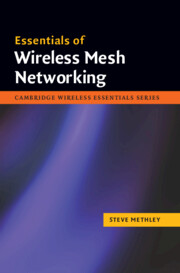Book contents
- Frontmatter
- Contents
- Preface
- Acknowledgements
- 1 Mesh overview and terminology
- 2 Attractive mesh attributes and applications
- 3 Fundamentals of mesh technology
- 4 Mesh capacity, scalability and efficiency – hypothesis testing
- 5 Mesh susceptibility
- 6 Mesh services and quality of service
- 7 Summary of potential mesh pitfalls to avoid
- 8 Appropriate telecommunications applications for mesh
- 9 Successful mesh implementations
- 10 Wireless sensor networks (WSNs) as mesh networks
- Abbreviations
- Selected definitions
- Appendix: Mobility models
- About the author
- Index
- Mesh hints and tips
1 - Mesh overview and terminology
Published online by Cambridge University Press: 01 March 2010
- Frontmatter
- Contents
- Preface
- Acknowledgements
- 1 Mesh overview and terminology
- 2 Attractive mesh attributes and applications
- 3 Fundamentals of mesh technology
- 4 Mesh capacity, scalability and efficiency – hypothesis testing
- 5 Mesh susceptibility
- 6 Mesh services and quality of service
- 7 Summary of potential mesh pitfalls to avoid
- 8 Appropriate telecommunications applications for mesh
- 9 Successful mesh implementations
- 10 Wireless sensor networks (WSNs) as mesh networks
- Abbreviations
- Selected definitions
- Appendix: Mobility models
- About the author
- Index
- Mesh hints and tips
Summary
The Internet is now firmly part of our everyday life. We perform many common tasks on-line, such as banking, grocery and gift shopping and the purchasing of travel or cinema tickets. Plus we get a growing portion of our entertainment from on-line sources: entertainment and social networking are two of the largest growth areas. We have seen the beginning of basic quality video from, for example, You Tube and the development of social networking sites such as My Space and FaceBook, which have been enormously popular, especially amongst younger generations of consumers. If we are to continue in this trend of doing more on-line, our need for bandwidth will increase. And in future we might expect to generate appreciable content ourselves, for upload onto the Internet, as well as to continue to download content. But that is not all; our need for Internet availability and quality will also increase.
It would be very convenient if such future Internet access were also wireless, with the near ubiquitous service we are used to from cellular phones. However, building a new network to achieve this, or upgrading an existing network to support this, would mean installing or changing a great deal of infrastructure. What then if a method existed which promised improved Internet access with fewer requirements for new infrastructure? This is widely advertised as the domain of the mesh network.
This chapter begins with a top-level introduction to mesh networking, then looks at how meshes may fit into the larger telecommunications infrastructure, before moving on to classify and explain the basic properties of a mesh.
- Type
- Chapter
- Information
- Essentials of Wireless Mesh Networking , pp. 1 - 14Publisher: Cambridge University PressPrint publication year: 2009
- 1
- Cited by



